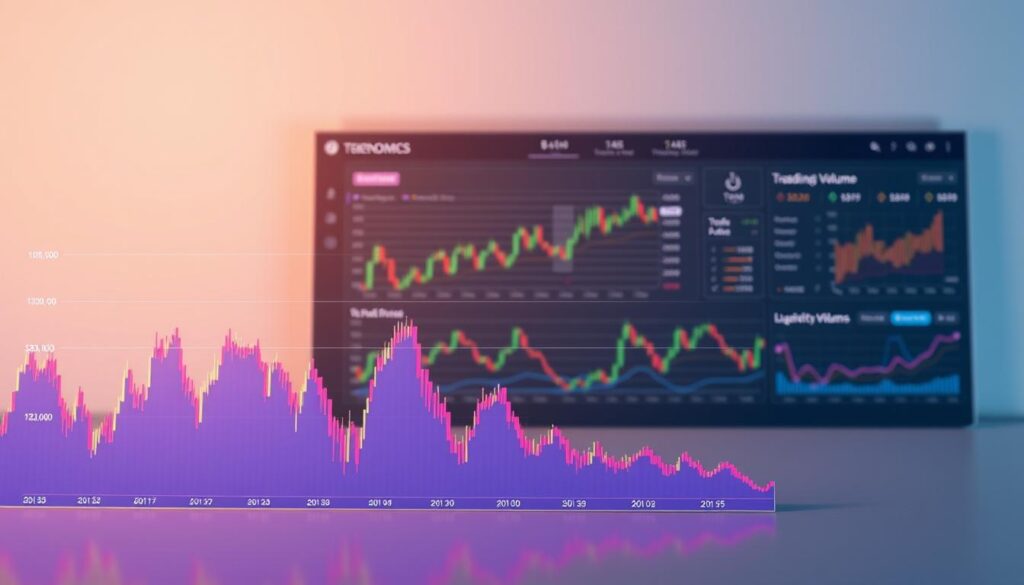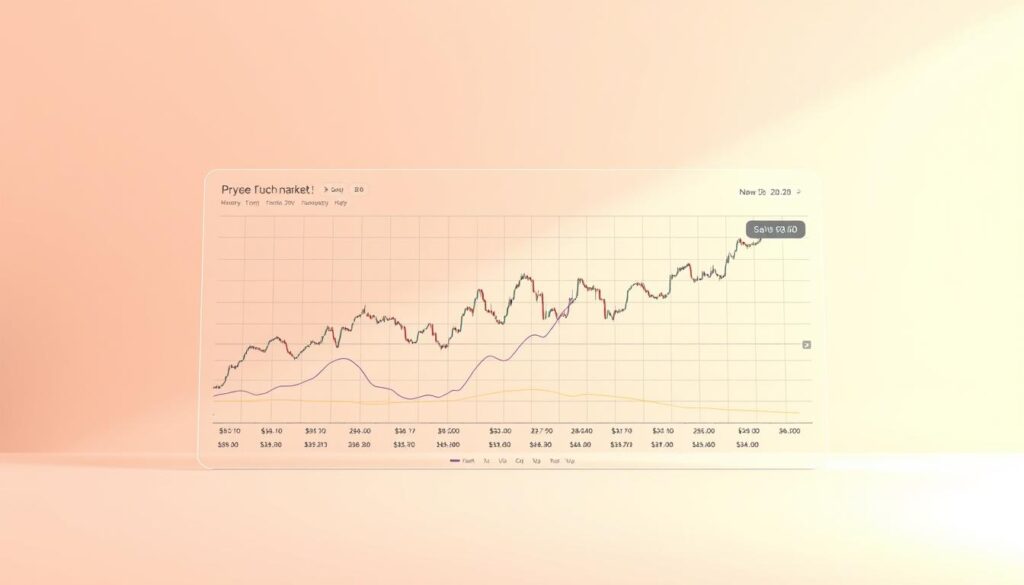Now Reading: Understanding Cryptocurrency Market Cap Ranking Analysis
- 01
Understanding Cryptocurrency Market Cap Ranking Analysis
Understanding Cryptocurrency Market Cap Ranking Analysis

Digital assets have transformed how people think about investing. The cryptocurrency market offers unique opportunities for growth and diversification. To navigate this complex space effectively, investors need reliable tools for comparison.
Market capitalization serves as the primary metric for evaluating digital currencies. This approach provides a standardized measure that goes beyond simple price comparisons. It reveals the true scale and investment potential of each asset.
Understanding how these rankings work helps investors make informed decisions. The system shows which digital currencies command the most confidence from the investment community. This knowledge provides valuable context for assessing risk and potential returns.
This guide explores the methodologies behind valuation metrics. It examines the platforms that aggregate and present financial data. Readers will learn to interpret information in context with other important factors.
Key Takeaways
- Market capitalization provides a standardized way to compare digital assets
- Rankings reveal which currencies have the most investor confidence
- This analysis helps assess the true scale of investment opportunities
- Multiple data sources and platforms offer comprehensive market views
- Understanding rankings supports better investment decision-making
- Context with other metrics creates a complete market picture
- Both beginners and experienced investors can benefit from this approach
Understanding Market Capitalization in Cryptocurrencies
The financial measurement known as market capitalization provides crucial insights into digital asset valuation. This metric offers a comprehensive view of an asset’s total worth in the ecosystem.
Definition and Calculation of Market Cap
Market cap represents the total dollar value of all coins currently available. The calculation involves multiplying the current price by the circulating supply. This figure is typically expressed in USD for global comparison.
The circulating supply refers to coins actively traded on the market. This differs from total supply, which includes locked or reserved tokens. Accurate assessment depends on using the correct circulating figure.
Market Cap vs. Price: Key Differences
Many investors confuse individual coin price with overall valuation. A coin priced at $1 can have a larger market cap than one at $100. The difference lies in the number of coins available.
Digital assets are categorized by their market cap size. Large-cap projects exceed $10 billion and show strong stability. Mid-cap assets range from $1-10 billion with balanced risk profiles.
Small-cap offerings fall below $1 billion and present higher growth potential. These newer blockchain projects often carry increased volatility. Understanding these categories helps investors diversify effectively.
Exploring the Significance of Crypto Market Data
The power of crypto market data lies in its ability to transform simple numbers into actionable intelligence. A single price point tells you very little. True understanding comes from context.
Platforms provide crucial metrics like trading volume and fully diluted valuation. This broader picture helps assess an asset’s true scale and stability. It moves beyond mere price speculation.

This information is aggregated from thousands of exchanges worldwide. Real-time aggregation smooths out price differences between platforms. Investors get a reliable, consolidated benchmark.
Data updates every few seconds, reflecting the non-stop nature of the market. This continuous flow is vital for monitoring investments at any hour. It empowers quick, informed decisions.
The table below shows how different data types work together to create a complete picture.
| Data Type | Primary Function | Significance for Investors |
|---|---|---|
| Current crypto prices | Shows immediate valuation | Snapshot of buying/selling price |
| Historical price data | Reveals trends and cycles | Helps distinguish volatility from value shifts |
| Trading Volume | Measures market activity | Indicates liquidity and investor interest |
This comprehensive approach democratizes information. Retail investors gain access to the same foundational data as large institutions. It levels the playing field for all participants in the crypto space.
Deep Dive: Cryptocurrency market cap ranking analysis
Behind every digital asset ranking lies a complex web of data processing and validation. Sophisticated systems work around the clock to ensure accurate valuations. These platforms process millions of data points every day from thousands of global exchanges.

Methodologies and Data Sources
Platforms use weighted average formulas for prices calculated across trading pairs. This approach prevents low-liquidity outliers from distorting the overall picture. Algorithms continuously monitor for anomalous tickers that could indicate errors.
Data sources include both centralized and decentralized trading platforms. The conversion to standardized USD pricing requires complex calculations. These systems account for exchange-specific liquidity conditions across different trading pairs.
The methodology behind valuation metrics also considers circulating supply changes. New token emissions and burning mechanisms affect the total coins available. This comprehensive approach ensures accurate market representation.
Real-Time vs. Historical Analysis
Real-time analysis provides up-to-the-minute rankings that update every few seconds. This captures the dynamic nature of trading that occurs 24 hours across global markets. Investors get current conditions reflected in the data.
Historical examination reveals long-term growth patterns and cyclical behaviors. This perspective helps distinguish between temporary volatility and genuine value shifts. Both approaches offer unique insights for different investment strategies.
| Analysis Type | Update Frequency | Primary Use Case | Data Points Processed |
|---|---|---|---|
| Real-Time | Every few seconds | Immediate decision making | Millions per day |
| Historical | Daily/Weekly aggregates | Trend identification | Billions over time |
Computer algorithms automatically filter price anomalies from individual exchanges. This maintains data integrity when technical glitches or flash crashes occur. The result is reliable crypto prices that the community trusts.
Evaluating Major Cryptocurrencies: Bitcoin, Ethereum, and Altcoins
Understanding the hierarchy of digital assets begins with a close examination of Bitcoin, Ethereum, and the vast universe of alternatives. These top cryptocurrencies represent the core of the ecosystem, each serving distinct roles.
Their positions are determined by market capitalization, a real-time calculation of price multiplied by circulating supply. This metric offers a standardized view of their total value in USD.

Comparative Analysis of Top Coins
Bitcoin (BTC) remains the undisputed leader. It functions primarily as a store of value, often called digital gold. Its BTC dominance metric shows its share of the total digital asset value.
High dominance often indicates a cautious market. Ethereum (ETH), the second-largest coin, powers a programmable blockchain. This network supports smart contracts and decentralized applications.
The fundamental differences between these leading coins are significant:
- BTC has a fixed supply cap, creating scarcity.
- ETH has a controlled but unlimited emission schedule.
- These circulating supply dynamics directly influence long-term valuation.
Beyond Bitcoin and Ethereum lie thousands of other cryptocurrencies, known as altcoins. Evaluating these top cryptocurrencies requires analyzing their unique utility and blockchain adoption. While many exist, investor confidence remains concentrated in the proven leaders.
Understanding Trading Volume, Liquidity, and Tokenomics
Beyond simple price points, trading activity tells a deeper story about investor behavior. The total USD value exchanged during a specific period, typically measured per day, reveals genuine market interest. This trading volume serves as a critical indicator of asset health.

High volume relative to valuation indicates strong liquidity. Investors can enter or exit positions without causing major price swings. This characteristic is essential for serious cryptocurrency trading strategies.
Impact on Market Rankings
Liquidity varies dramatically across different digital assets. Top projects offer deep order books on multiple exchange platforms. Smaller token offerings may have limited trading opportunities and wider spreads.
The relationship between volume and valuation reveals market efficiency. Assets with proportionally high trading volume demonstrate active price discovery. Low volume relative to size suggests potential manipulation.
Exchange listings significantly affect both trading volume and liquidity. Assets available on major platforms attract more participants. This creates tighter spreads and better execution for cryptocurrency trading.
Tokenomics—the economic model governing supply and distribution—fundamentally impacts positions. Factors like emission rates and burning mechanisms affect circulating supply over time. These dynamics create predictable or unpredictable effects on valuation metrics.
Inside Leading Platforms: CoinGecko and CoinMarketCap
When investors seek reliable crypto prices, they typically turn to a pair of industry leaders. These platforms process immense amounts of data from global trading venues.
CoinGecko emerged as a comprehensive source for digital asset information. It covers thousands of verified coins and trading platforms. The service aggregates information around the clock.
Data Aggregation Techniques
Both platforms collect data from exchange APIs every few seconds. This continuous flow ensures crypto prices reflect current conditions. Sophisticated algorithms process millions of data points daily.
The prices calculated use weighted averages across trading pairs. High-volume markets receive greater influence in final figures. This prevents small trades from distorting overall valuations.
Each listed coin undergoes manual vetting before inclusion. Teams remove scam projects and inactive cryptocurrencies. This curation maintains platform integrity and user trust.
Real-time crypto charts display price movements across customizable timeframes. Investors can track performance from hours to years. The visual tools help identify patterns and trends.
API services power thousands of third-party applications. Portfolio trackers and trading bots rely on this infrastructure. The platforms serve as essential data hubs for the entire ecosystem.
Leveraging Crypto Data for Strategic Investment
Building a successful portfolio requires more than just tracking price movements. Strategic investors use comprehensive crypto market data to identify opportunities that match their risk tolerance. This approach transforms raw numbers into actionable intelligence.
Risk Management and Opportunity Identification
Market capitalization categories provide the foundation for risk assessment. Large-cap assets like Bitcoin function as digital gold with relative stability. Smaller projects offer higher growth potential but carry increased volatility.
If you’re willing to accept greater risk, mid and small-cap cryptocurrencies can provide substantial returns. These assets often experience rapid growth during adoption phases. However, they require careful monitoring and research.
Dominance metrics reveal important capital rotation patterns. Shifts between Bitcoin and altcoin dominance signal changing investor sentiment. These patterns help identify emerging opportunities in different market segments.
The table below shows how different risk profiles align with various market capitalization categories:
| Risk Profile | Recommended Market Cap | Potential Return | Volatility Level |
|---|---|---|---|
| Conservative | Large-cap (>$10B) | Moderate | Low |
| Balanced | Mid-cap ($1-10B) | Moderate-High | Medium |
| Aggressive | Small-cap ( | High | High |
Strategic cryptocurrency trading involves monitoring multiple data points simultaneously. Volume trends, news catalysts, and technical indicators help spot accumulation phases. This comprehensive approach supports better decision-making.
Portfolio construction should balance stable large-cap assets with selective smaller positions. If you’re willing to diversify properly, you can manage risk while pursuing growth. This balanced strategy works across different market conditions.
Trends Shaping the Future of Cryptocurrency Markets
Recent developments in decentralized technologies have introduced new paradigms for financial interactions. These innovations are transforming how value moves across global systems.
The evolution centers around programmable assets and automated agreements. These tools create more efficient and accessible financial services.
The Role of Stablecoins and Smart Contracts
Stablecoins provide price stability by pegging value to traditional assets. Tokens like Tether (USDT) maintain their worth against fiat currencies. This stability enables practical use cases beyond speculation.
These digital assets serve as primary trading pairs on many platforms. They allow users to operate within the crypto ecosystem without constant conversion.
Smart contracts on blockchain networks enable self-executing agreements. They power decentralized finance applications and automated financial instruments. This technology removes intermediaries from complex transactions.
Emerging Financial Instruments
New financial tools are expanding what’s possible with digital assets. Yield farming and liquidity mining represent innovative earning opportunities.
The tokenization trend extends beyond digital currencies. Real-world assets like real estate and commodities can become tokens on blockchain networks. This expands the total addressable market for this technology.
Projects exploring integration with traditional finance show significant promise. As cryptocurrency trends evolve, these instruments gain sophistication.
| Instrument Type | Primary Function | Blockchain Network | Adoption Level |
|---|---|---|---|
| Stablecoins | Price stability & payments | Multiple networks | High |
| Governance Tokens | Community decision-making | Ethereum, Solana | Medium |
| Synthetic Assets | Track real-world prices | Various platforms | Growing |
| NFTs | Digital ownership | Ethereum, Flow | Expanding |
These developments represent just the beginning of what’s possible. The intersection of traditional finance and blockchain technology continues to produce innovative solutions.
Challenges and Considerations in Market Cap Ranking
Investors relying on market cap rankings must understand the limitations and data quality issues that impact these valuations. While platforms like CoinGecko work to provide accurate information, several factors can affect ranking reliability.
Determining true circulating supply presents the first major hurdle. Many projects lack transparency about locked tokens or team holdings. This affects how many coins are actually available for trading.
Accuracy and Data Anomalies
Exchange technical glitches can create price outliers that don’t reflect true value. Platforms use sophisticated algorithms to detect and exclude these anomalies. This maintains ranking integrity across thousands of digital assets.
Definitions of circulating supply vary between tracking services. Some cryptocurrencies may appear more valuable than their liquidity justifies. Projects sometimes manipulate tokenomics to inflate their apparent worth.
News events and social media can cause rapid valuation changes. Viral attention may drive trading disconnected from fundamental value. These temporary distortions require careful interpretation.
| Data Challenge | Impact on Rankings | Platform Solution |
|---|---|---|
| Supply Transparency | Inaccurate market cap calculations | Manual project vetting |
| Exchange Anomalies | Temporary price distortions | Algorithmic filtering |
| Cross-Chain Tracking | Potential double-counting | Careful data aggregation |
| Inactive Projects | Noise in rankings | Regular delisting procedures |
Regulatory news can cause sudden valuation changes that persist until clarity emerges. Investors should remember that market cap provides a snapshot rather than guaranteed liquidity.
When comparing different digital assets, context remains crucial. Two projects with similar cryptocurrency market cap figures may have vastly different liquidity profiles. This makes some valuations more substantial than others.
Conclusion
As blockchain technology matures, the sophistication of investment tools available to participants continues to expand. This evolution empowers both new and experienced investors with unprecedented analytical capabilities.
Understanding valuation frameworks provides essential context for navigating the dynamic world of digital assets. These comprehensive approaches help investors balance risk across different asset categories while identifying genuine opportunities. Proper interpretation of financial data transforms raw numbers into actionable intelligence.
The landscape for cryptocurrencies will keep evolving with emerging trends and innovations. Investors equipped with solid analytical foundations position themselves to thrive in this transformative market. Strategic participation in the crypto space requires continuous learning and adaptation to new developments.
FAQ
What is the difference between a coin’s price and its market cap?
The price is the cost of a single token, like Bitcoin or Ethereum. Market cap reflects the total value of all coins in circulation. It’s calculated by multiplying the current price by the circulating supply. A high market cap often indicates a more established and less volatile asset.
Why is trading volume important when looking at crypto charts?
Trading volume shows how much of a digital asset is being bought and sold. High volume typically means there is strong interest and good liquidity, making it easier to execute trades without affecting the price drastically. It’s a key metric for confirming trends.
How do platforms like CoinGecko and CoinMarketCap gather their data?
These platforms aggregate price data from numerous exchanges worldwide. They use sophisticated algorithms to calculate a volume-weighted average price, ensuring the figures represent a broad market view rather than just one exchange’s activity.
What does BTC dominance mean on a crypto market overview?
Bitcoin dominance measures Bitcoin’s market capitalization as a percentage of the total crypto market cap. When dominance is high, it suggests that investors are favoring BTC over altcoins. A falling dominance often indicates a “altcoin season,” where other tokens are gaining value faster.
How do stablecoins like Tether (USDT) impact the overall market?
Stablecoins provide a safe harbor during market volatility, as their value is pegged to fiat currencies like the US Dollar. They offer crucial liquidity, acting as a primary trading pair on many exchanges and allowing traders to move in and out of positions quickly.
What are some common challenges with cryptocurrency market data?
Data accuracy can be affected by anomalies like wash trading on some exchanges, where fake volume is created. Additionally, calculating the true circulating supply for some tokens can be complex, which may lead to slight inaccuracies in the reported market cap.














